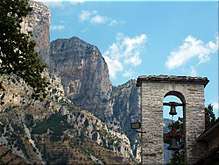Zagori
Understand
It has an area of some 1,000 square kilometers and contains 46 villages. Most developed with touristic infrastructure is the western part but also consider visiting eastern Zagori, which is far less developed in a touristic sense but just as impressive.
Villages
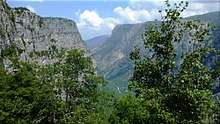
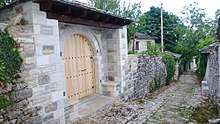

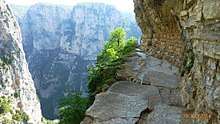

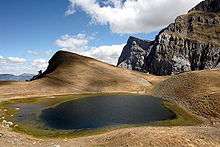
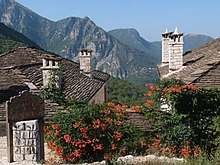
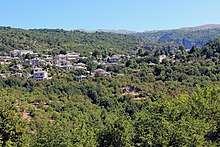

- 🌍 Tsepelovo. A traditional village (altitude 1,080 m) with a picturesque cobblestone square. The church of Aghios Nikolaos (18th century) is worth visiting.
- 🌍 Monodendri. one of the nicest villages of the area (altitude 1,060 m) completely build in the traditional style with stone houses, stone roofs and even stone pavement. It’s a “must see” location and a good place to stay in one of the hotels. Several restaurants and bakeries offer their service. There is no night life except the restaurants and hotel bars. During the day the central square is a nice place to rest in a cafe and to enjoy the architecture and to the watch street life in summer. In winter time Monodendri has Greek tourism that enjoy wintry cuddly by the fireplace. Many hotel rooms have a fireplace in the rooms. Foreign tourists prefer Monodendri in summer time as starting point for hiking and sightseeing. Don’t miss to walk through the small side roads in the village. From the main square next to the Agios Athanathios chruch a cobblestone trail leeds 800 m downhill to the Convent of Agia Paraskevi(15th century). The small church is nestled between rocks in fantastic nature on the edge of the Vikos Gorge. Vikos is listed as the deepest gorge in the world by the Guinness Book of Records with a length of about 20 km, depth ranging from 120 to 490 m, and a width ranging from 400 m to only a few meters at its narrowest part. Enjoy the outlook from the convent and walk along the path which begins above the church. The path leads directly to the steep rock without any rail. It takes a lot of nerves and no fear of heights but for that one is in the midst of an incomparable mountain landscape. Following the path you reach other wonderful vantage points. Leaving Monodendri on the west side, the road leads to the Stone Forest after about 5km. Stones are naturally located horizontally on top of each other forming well worth seeing groups of stone pillars. If you continue another 2km further you will make your way to Oxia viewpoint where you can see Vikos Canyon. It’s another “must see” location due to the fantastic outlook.
- 🌍 Kipi. the very popular traditional village (altitude 800 m) is worth seeing especially do to the more than 5 spectacular old stone bridges from 1 to 3 arcs around the village. The bridges are signposted and close to the road.
- 🌍 Koukouli. A traditional village with large villas and fountains of exceptional popular architecture
- 🌍 Dilofo. the village (altitude 880 m) is built amphitheatrically on the foot of two hills. The well known hotel “Arhontiko Makropoulou” is the starting point for trails leading to the picturesque chapels of the village
- 🌍 Papingo. Papingo (altitude 960 m) and the upper Mikro Papingo are very popular typical "must see" stone build villages in a fantastic mountainous surrounding. Both have nice traditional taverns, hotels and guest houses. The elementary school in Papigo houses the Zagori Nature and Culture Information Centre. The best view of the Vikos gorge is from the Taxiaches Chruch at Mikro Papingo. Before you reach the villages via a narrow winding road, you cross a mountain river. The Voidomatis River even in mid-summer is so cold that you can swim only a few seconds in it. From a parking lot at the bridge you can reach many places along the river that invite you for a picnic in the beautiful surroundings. This is the perfect place to rest at hot summer days. Another attraction are the Papingo Rock Pools which are situated between the two Papigos.You can even dive in early summer. Late summer there might be no water depending on the waether. The formations in the rocks are truly beautiful and it is a lovely place to cool off and have a picnic.
- 🌍 Vikos. The little village (altitude 770 m) is worth seeing especially do to its viewpoint where you have one of the best views over the Vikos canyon. The springs of the Voidomatis river can be reached in 30 minutes on hiking trail from the village.
- 🌍 Aristi. The main attraction of the village is the Monastery of Panagia Spileotisas (16th century), built in a beautiful location near a bridge of the Ottoman era on the Voidomati river that forms the gorges of Vikos. The church stands near the entrance to a cave.
- 🌍 Kaloutas. The traditional village is known for its old churches, a "must see" triple arch bridge and the Despotis Spring which is located nearby. Also the Monastery of Vivikou, 4.5 km N of Kaloutas. is worth visiting.
- 🌍 Vrisohori. A traditional village (altitude 940 m) with numerous springs and plentiful running water.
- 🌍 Tristeno. a beautiful mountain village (altitude 940 m) with its plentiful running waters, springs and a watermill from the 19th century and the Aghios Georgios church is sight to see.
Other destinations
- 🌍 Vikos–Aoös National Park - It is named after the two major gorges of the area. It is a steep mountainous terrain with numerous rivers, lakes, caves, deep canyons, dense forests
Understand
Zagori is the name of a region of Epirus north of Ioannina, dotted with innumerable villages in traditional style. The impressive landscape with high mountains, dense barely inhabited forests and impressive gorges and the wild beauty of the Zagoria mountain villages captures every visitor. The houses and streets of the small typical mountain villages are built entirely of stone. The same applies to the many monasteries and churches. Another attraction are the stone arch bridges which are true masterpieces of traditional bridge construction. They all date back to the Ottoman era. It is a destination suitable for eco-tourism lovers.
A problem for tourism is the unsteady climate due to the mountainous climate with often rain and low temperatures, unexpected by many visitors that know Greece only from sunny hot beaches. Each of the four seasons is suitable for a visit to the Zagori region. Winter, despite being characterized by inclement weather, allows you to enjoy the spectacle of snow-covered villages, giving them a fairytale atmosphere and out of time. Walking through the alleys in stone you will perceive the pungent smell of wood burning in the chimneys of houses and taverns where the locals meet and the rare tourists in convivial youth accompanied by wine and often of tsipuro. Already at the end of February snow starts to melt. Especially pleasant are the short walks along the course of rivers and streams where the water returns to flow impetuously, interspersed with pieces of ice. The summer is, like everywhere in Europe, the season that sees a greater influx of tourists, which partly contributes to depress the magic of the villages of Zagori. However, visitors are not so numerous and weather is more stable and warm enough for a bath in rivers or lakes. Finally, autumn is also a good season for a visit attributed to the foliage that takes on very bright colors between red copper and vermilion. With the advance of autumn the leaves improrogabilmente fall covering the paths of a thick multicolored carpet.
Get in
Most visitors come by (rental) car from Ioannina. Buses from Ioanina Ktel to the Zagori villages run on regular scedule.
Get around
The best way to explore this region is by car. Public transport is available but far too time consuming and buses do not stop at the many viewpoints or other points of interest in-between the villages. For people who are good on foot there are also many signposted hiking trails that lead to the many attractions. With disabilities, the whole area is difficult and the attractions hardly accessible.
See
The main thing to see is the stunning landscape and the old style villages with their old stone bridges.
- 🌍 Monument to Zagorian Women. The monument is dedicated to the Zagorian women in memory of their help in the fight against the invading Italian troops in the fall of 1940. The statue was erected in 1993 and has a height of 6, Women of Zagoria in the '40 war actively participated in the fight and participated in the supply of Greek forces who fought to stop the fascist invasion that was trying to reach Metsovo through the Aoos valley.
- 🌍 Waterfall of Iliohore. A steep 2-km path leads down to the waterfall, but it is well worth to go and to have a bath in summer in the ice cold water.
- 🌍 Drakolimni. It is a beautiful alpine lake at 2100m reachable by a demanding hike from Papingo. It takes around 3h from the village to the Astraka refuge and another 1.30h to the lake. The route to the lake is a bit easier than to the refuge. As it is a rather long walk for one day it is advisable to stay at the refuge overnight. The view at each point of the climbing is stunning.
- 🌍 Skalopatia Vradeto. A moderate hiking trail of 3km in the footsteps of the old builders of this stairs that you can climb from the village of Kapesovo to the village of Vradeto and continue 1km to the Beloi hike starting point Very beautiful nature. For those who don’t want to climb stairs and rocks you can go from the top site of mountain in Vradeto and have just a view of the whole path from there.
Do
- Hiking. There are about 30 marked trails in Zagori that connect most of the attractions
- Rafting. There are several suitable rivers for all levels of difficulty
- Touring Ski.
- Horse riding.
- Mountain biking.
- Canyoning.
Buy
Best things to buy are agricultural products of the area that includes honey, herbs, herbal teas, Feta cheese and hard cheese and goat or sheep meat.
Eat
A speciality of the area are Pittas, which are pies filled with cheese (Tiropita), Spinach (Spanakopita), wild greenstuff (Hortopita), pumpkin (Kolokothopita - which can be either sweet or salty) or Spinach plus feta cheese (Tirospanakopita). Also try goat and sheep meat of the area. The meat has very good taste as the animals graze freely and eat many different grasses.
Drink
Try the wines from the region and the Zipouro, a pomace brandy. During wine production, after pressing the grapes, the pomace falls as a waste product, which is then fermented and distilled. The more often it is distilled, the better the schnapps. Standard is a 2 times distillation. This is Zipouro (also called Raki or Tsikoudia). If anise or fennel is added to the distillation, the Zipouro tastes like ouzo. At the Zagori region normally no Anis is added and the taste is pure. It's the same product that is called Grappa in Italy.
Sleep
Most visitors stay in one of the many hotels and guesthouses in Monodendri, Papingo or Kipi. In these villages is also few nightlife, while in the smaller villages this is less. Almost all hotels or guest houses are built and furnished in the traditional style and are listed and rated in the well-known Internet booking sites.
Stay safe
The area is very safe in terms of crime and the only real danger is the wild nature with steep slopes, lonely forests where an injured hiker can not be found immediately. It is recommended to inform someone if you want to go a secluded trail. Not everywhere the mobile net is good to get emergency help.
